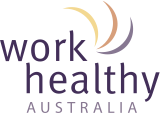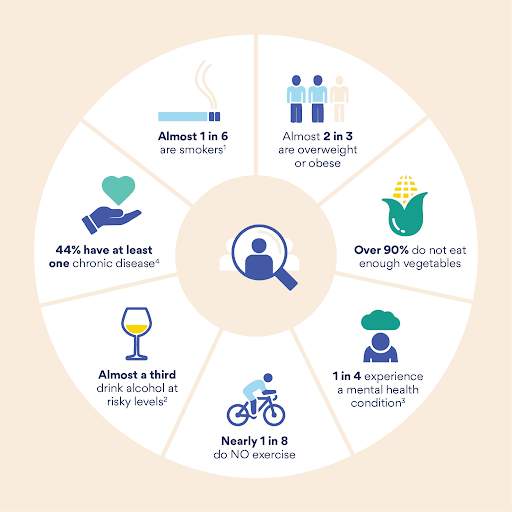
Complimentary health checks can improve employee morale and can also provide insights into the overall health of your workforce.
How healthy is your workforce?
The workplace is increasingly becoming the centre stage of health promotion initiatives to support employee health and prevent chronic disease.
Interest in workplace health and wellbeing programs is growing worldwide, according to The Organisation for Economic Co-operation and Development, due in part to population ageing, the increase in chronic health conditions, and the rise in health consciousness after the COVID-19 pandemic.
Looking after your employees’ health makes sense since they are your most important resource. In this article, we explain the links between health and productivity, and show how your organisation can take steps towards measuring the health of your workforce.
Why healthy workers mean better business
Many studies show a direct link between healthy workers and productivity. In a workplace survey, Medibank Private demonstrated that employees with poor overall health take up to nine times more sick leave than their healthy colleagues. That study also showed that healthy employees are nearly three times more productive than employees with poor health.
Unhealthy lifestyles and dietary choices can contribute to fatigue, which could lead to safety risks. Certain health conditions such as diabetes and cardiovascular disease are risk factors for musculoskeletal disorders and can also delay injury recovery.
The Australian Institute of Health and Welfare explains how important it is to maintain the health of working-age Australians, as it has repercussions beyond the individual. “The health of people of working age is important because it affects not only them, but their families, workplaces, and society in general. Gaining a better understanding of this group’s health and lifestyles can lead to improvements in their wellbeing and to overall improvements in productivity and planning for future health needs.”
There are several benefits for organisations that promote physical activity and employee health in the workplace, including:
- Increase in employee productivity
- Reduced absenteeism and sick leave
- Reduced risk of employees developing chronic diseases and injuries
- Increase in employee morale
- Improved employee attraction and retention

Government push for health initiatives
Several state workplace authorities are encouraging employers to look beyond their health and safety obligations and also focus on the overall health of their workforce:
Worksafe Queensland says “workers who suffer from physical or mental health conditions are likely to have higher rates of injury, illness, absenteeism and presentism”. They have a number of dedicated resources for employers on their website to encourage health and wellbeing initiatives in workplaces.
The government of South Australia, in partnership with other agencies such as SafeWork SA, has developed the Healthy Workplaces program to help employers improve health and wellbeing in their workplaces: “Creating a healthy workplace makes good business sense – it benefits both businesses and people”.
Four things you can do at your workplace:
1. Analyse barriers to recovery
One of the first steps employers can take is to monitor their organisation’s health. Workplace injury data gathered from early intervention services and injury management logs can reveal underlying conditions that could be preventing workers from recovering from their injuries and improving their overall health and wellbeing. Understanding the most common barriers to recovery at your workplace can assist in understanding the most common health conditions impeding recovery.
2. Survey your workers
One of the best ways to understand your workforce is to engage with your workers. Surveys, forums and meetings can be a starting point for understanding your workers’ health goals and barriers. Supervisors and managers who have a good rapport with and know their staff can also provide useful information regarding health barriers workers might be facing.
3. Understand your industry
Research has demonstrated that certain industries are more prone to chronic disease risk factors and that different sectors have different health challenges. For example, the public service industry has higher obesity rates and waist circumference than the national average, whereas the construction industry has higher rates of smoking and harmful alcohol consumption. Many health care and social assistance jobs involve long hours and shift work, leading to poorer health outcomes like depression, fatigue, type 2 diabetes, musculoskeletal and gastrointestinal disorders, cardiovascular disease, and some cancers.
4. Offer free and confidential health checks
Lifestyle health checks completed online or in person can give you important insights into the health issues that your workers are facing and what they view as priorities. Your employees can benefit from gaining a better understanding of their overall health, and understand what opportunities might exist to improve their wellbeing, all whilst under the guidance of a health professional. Individual health checks can also provide de-identified population health reports which can inform targeted health initiatives and strategies to lower injury and health-related risk within the workplace. Health checks also offer the soft benefit of helping to show you care for your employees, improving morale and culture within the workplace.

There is no one-size-fits-all approach to enhancing employee health. However, successful workplace health promotion initiatives have a few things in common:
- Visible support and participation of senior management
- Workers are consulted and involved as co-designers
- Programs are aligned with the overall business aims
- Monitoring and evaluation are embedded in the program
- Employers understand the complexity of behavioural change
Believing that you could transform your workforce with a single health promotion program would be simplistic. Research shows that the adoption of healthy behaviours is influenced by factors operating at and between individual, family, workplace and industry levels.
However, by understanding the health needs of your workforce, you will demonstrate to workers that you care about them. Understanding the health conditions most common in your industry and workforce will enable strategies to be designed that are suited to the needs of your workforce. The most effective workplace health promotion initiatives are based on the specific needs of the workers, rather than those which adopt a one-size-fits-all approach.
Related articles
Sign up to our monthly enewsletter
"*" indicates required fields



